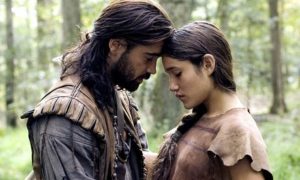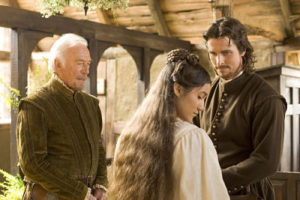STUDIO: Criterion | DIRECTOR: Terrence Malick | CAST: Colin Farrell, Q’orianka Kilcher, Christian Bale, Christopher Plummer, August Schellenberg, Wes Studi
RELEASE DATE: 7/26/16 | PRICE: DVD $29.99, Blu-ray $34.99
BONUSES: Four new featurettes containing interviews with the lead performers, crew, and editors; a comparison of the three versions of the film; “Making The New World” documentary; historical materials on the reality behind the film’s plot
SPECS: NR | 172 min. | Drama | 2.35:1 widescreen | 5.1 Surround
Terrence Malick (Badlands, Days of Heaven, The Tree of Life) occupies a very unique place in contemporary American cinema. He’s an “arthouse” visionary whose films play in multiplexes in some cities. Since his “comeback” film in 1998, The Thin Red Line, he’s been able to craft his works to his exact specifications, and unlike the other directors who can do that (Scorsese, Spielberg, et al), he is almost exclusively interested in pictorial storytelling.
The New World, given the super-deluxe Criterion treatment here (three discs in the Blu-ray release, four in the DVD), was a turning point for him — the last time he made a film with a linear plotline and the only time he has tackled a period piece based on real events.
Make that some real events, for the film retells the love story of Captain John Smith (Colin Farrell, The Way Back) and Pocahontas (Q’orianka Kilcher), two real historical figures who never had a love story. So, in a film filled with fascinating contradictions, Malick chose to make an incredibly realistic and historically accurate chronicle of the founding of the Jamestown settlement that just happens to be built around a very popular myth. (Pocahontas was in fact nine years old when the fictional romance would’ve taken place.)
Disregarding this rather curious decision — which Malick buries by not having the Native American princess verbally referred to as “Pocahontas” — the film is a strikingly beautiful creation, an immersive experience that is closer to a poem or a painting than a conventional movie.
The Criterion edition of The New World contains not one but three versions of the film: “the first cut” (150 minutes), “the theatrical cut” (135 mins), and “the extended cut” (172 minutes). The last-mentioned is the one that Malick fans will want to see, but it is oddly not the rarest — it had been released on DVD by New Line already, while the “first cut” has never seen the light of day until now.
The extended cut allows for more of the dazzlingly gorgeous glimpses of nature that Malick has become famous for, and includes more intimate moments (sans any sort of physical intimacy, including kissing, because the female lead was 14 years old when she made the film). This longer version also seems to “smooth” the transition from the Smith-Pocahontas romance to the Princess’s marriage to John Rolfe (Knight of Cups‘ Christian Bale, as another real historical character, who did in fact marry Pocahontas).
Editor Mark Yoshikawa speaks at length about the differences between the different cuts of the film in an onscreen interview. He stresses that the extended cut gives several sequences “the room to breathe” that wasn’t possible in the other two versions.
He also notes that the extended cut is not the earliest version of the film (which was indeed longer than anything seen here — a short “Oscar nomination” release of the 150-minute version was the first version shown in theaters). It was instead a special project that he and Malick undertook after the 135-minute theatrical cut had been honed down — Malick apparently was counting on a DVD release of a longer version.
A second interview with Yoshikawa appears in a featurette devoted to three of the four editors of the film. Here two of the editors, Hank Corwin and Saar Klein, share their recollections of working with Malick, who is described as “the most collaborative and least collaborative filmmaker” they ever worked with.
Malick broke the film up amongst the editors, giving each of them a significant segment of the plot. It is noted that they had an enormous amount of options since, all told, Malick shot what is referred to as “a couple hundred hours” of footage.
Given the fact that Malick is primarily a visual director — whose three films since New World have been non-linear narratives (based on his own personal mythology) — it’s no surprise to hear the editors speak about how they had to eliminate the director’s voice from the audio track.
For Malick truly is a silent-movie director, as he often speaks to his actors as scenes are being shot. As for linearity, Corwin notes that Malick became so frustrated on New World because he did have to put the scenes in a chronological order that he vowed at one point, “This is the last time I do a film with a plot!”
The documentary “Making The New World,” which has been issued before on previous DVD releases, gives viewers a look at what it is like on Malick’s location shoots (with the camera-shy filmmaker avoiding the documentarians at all costs — he refuses to give interviews or even to be filmed or photographed).
A featurette that was newly made for this set lets three of his collaborators speak at length. His longtime production designer, Jack Fisk, details what it was like finding the right look for the Jamestown settlement. Costume designer Jacqueline West, in turn, notes that she had to apply for a fur trading license to acquire the amount of leather she needed for the costumes.
However, the best stories in the featurette come from producer Sarah Green, who reveals that, even though Malick assured her he would need no lighting equipment on the location shoots, she budgeted for lighting rigs and had electric cables buried underground across the locations to ensure ease of use. Of course, Malick proceeded to use natural light in all of the location shots (which constitute a good deal of the film’s running time, in all three versions).
Green also quickly learned not to point out continuity errors, as Malick’s films are so dreamlike that any disparities from shot to shot aren’t important and wind up adding to the visual splendor of the film.
The film’s two leads talk about Malick’s very unique approach to filmmaking in another featurette made for this set. While Farrell jokes about his character’s “Eighties rock hairdo,” he speaks very highly of Malick’s spontaneous approach to filmmaking, in which Farrell and the other cast members would receive new pages of the script as Malick came up with them (while the shoot was already going on).
Kilcher talks about her initial difficulty with this approach, since New World was her first starring role, she was 14 at the time, and Malick would have her memorize speeches that he then chose to never shoot — asking her instead to act out the missing dialogue with a look or gesture.
Both performers talk about the film as a high point in their careers, but Farrell did get one blessing conferred on no other cast member. Malick allowed him to shoot scenes of Kilcher walking in the forest, in an effort (one assumes) to truly let the viewer see her “through the eyes” of Captain John Smith.
|
Buy or Rent The New World
|
|||
|---|---|---|---|
 |
|||


Leave a Reply